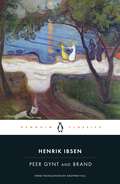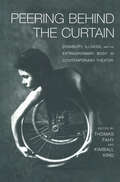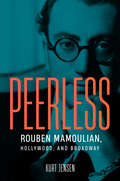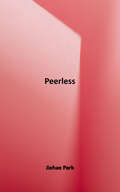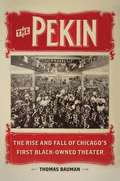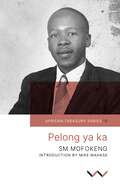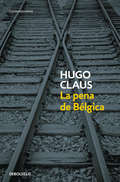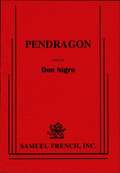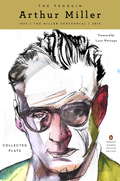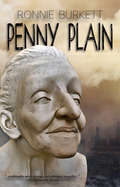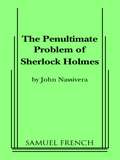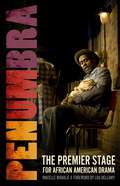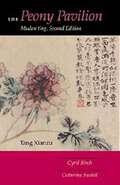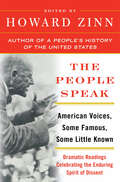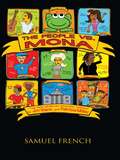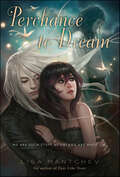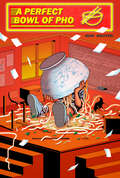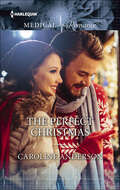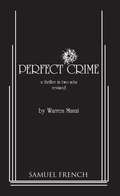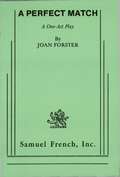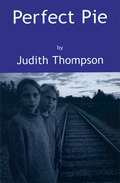- Table View
- List View
Peer Gynt and Brand
by Henrik IbsenA new Penguin edition of Ibsen's two great verse plays, in masterful versions by one of our greatest living poets, Geoffrey Hill. These two powerful and contrasting verse dramas by Ibsen made his reputation as a playwright. The fantastical adventures of the irrepressible Peer Gynt - poet, idler, procrastinator, seducer - draw on Norwegian folklore to conjure up mountains, kidnappings, shipwrecks and trolls in an exuberant examination of truth and the self; while Brand, an unsparing vision of an idealistic priest who lives by his steely faith, explores free will and sacrifice. This volume brings together the poet Geoffrey Hill's acclaimed stage version of Brand with a new poetic rendering of Peer Gynt, published for the first time.This Penguin edition includes an interview with Geoffrey Hill about recreating Ibsen in English, an introduction by Janet Garton and editorial materials by Tore Rem.
Peering Behind the Curtain: Disability, Illness, and the Extraordinary Body in Contemporary Theatre (Studies in Modern Drama #18)
by Thomas Fahy Kimball KingFirst Published in 2002. Routledge is an imprint of Taylor & Francis, an informa company.
Peerless: Rouben Mamoulian, Hollywood, and Broadway (Wisconsin Film Studies)
by Kurt JensenA proud Armenian who claimed a distant link to nobility, born in what was then part of czarist Russia, Rouben Mamoulian (1897–1987) was one of the most astonishing and confounding figures in American film and theater, directing the original stage productions of Porgy and Bess, Carousel, and Oklahoma!, as well as films including Love Me Tonight, Queen Christina, City Streets, and Silk Stockings. He was famously fired from the film version of Porgy and Bess in a dispute over publicity and quit Cleopatra after arguments over a single scene. Mamoulian’s mercurial confidence and autocratic tendencies were among the reasons he had a reputation for being uncompromising. This frustrating mix of genius and stubbornness, of critical successes and financial flops, has proven challenging for biographers. Kurt Jensen’s magisterial volume, extensively researched and filled with trenchant observations, brings to life this charming, flawed, and fascinating man—and demonstrates how the wellspring of his art contained the seeds of his own destruction. Drawing upon Mamoulian’s unfinished memoir and voluminous diaries, as well as interviews with the director’s surviving collaborators, Jensen delivers fresh and informative insider stories from seminal productions. Meanwhile, he explores Mamoulian’s aesthetic principles and strategies as manifested in lighting, choreography, and sound design. A tour de force, Peerless offers readers a multifaceted, in-depth look at an idiosyncratic genius.
Peerless
by Jiehae ParkAsian-American Twins M and L have given up everything to get into The College. So when D, a one-sixteenth Native American classmate, gets "their" spot instead, they figure they've got only one option: kill him. A darkly comedic take on Shakespeare's Macbeth about the very ambitious and cut-throat world of high school during college admissions.
The Pekin: The Rise and Fall of Chicago's First Black-Owned Theater
by Thomas BaumanIn 1904, political operator and gambling boss Robert T. Motts opened the Pekin Theater in Chicago. Dubbed the "Temple of Music," the Pekin became one of the country's most prestigious African American cultural institutions, renowned for its all-black stock company and school for actors, an orchestra able to play ragtime and opera with equal brilliance, and a repertoire of original musical comedies. A missing chapter in African American theatrical history, Bauman's saga presents how Motts used his entrepreneurial acumen to create a successful black-owned enterprise. Concentrating on institutional history, Bauman explores the Pekin's philosophy of hiring only African American staff, its embrace of multi-racial upper class audiences, and its ready assumption of roles as diverse as community center, social club, and fundraising instrument. The Pekin's prestige and profitability faltered after Motts' death in 1911 as his heirs lacked his savvy, and African American elites turned away from pure entertainment in favor of spiritual uplift. But, as Bauman shows, the theater had already opened the door to a new dynamic of both intra- and inter-racial theater-going and showed the ways a success, like the Pekin, had a positive economic and social impact on the surrounding community.
Pelong ya Ka (African Treasury Series #1)
by Sophonia Machabe MofokengPelong ya Ka, a collection of essays and sketches in Sotho was first published in 1962 in the Bantu Treasury Series imprint of Witwatersrand University Press. S. Machabe Mofokeng is regarded as one of the greatest essayist and dramatist in Southern Sotho. His first book, Senkatana (a play) was published in 1952.Pelong ya Ka comprises 20 essays which range from meditative, descriptive, and narrative to polemic style, with the tone of voice characterised by melancholy, humour, and satire. The essays span over a wide range of themes, as suggested by their titles, e.g. Pelo (The heart), Bodutu (‘Solitude’), Death (‘Lefu’), Nako (‘Time’), Pampiri (‘Paper’), Ho kganna mmotokara (‘Driving an automobile’), Sepetlele (‘Hospital’), Lenyalo (‘Matromony’), and Boqheku (‘Old age’). Nhlanhla Maake says of this collection “Mofokeng’s essays fuse simplicity with dept.” Pelong ya Ka is part of the African Treasury Series published by Wits University Press.
La pena de Bélgica
by Hugo Claus«Hugo Claus no necesitaba ningún maestro, él era un maestro.»CEES NOOTEBOOMAmbientada en Bélgica durante los últimos años del III Reich, esta novela narra la adolescencia de Louis Seynaeve, hijo de una familia pequeñoburguesa y ultraconservadora, orgullosa de su propia inanidad. Con el paso de los años, Louis, desencantado, abandona los mitos de la niñez y descubre la naturaleza hipócrita del mundo adulto. Obra de factura clásica y proporciones épicas, polémica, hilarante y cruda a partes iguales, La pena de Bélgica es uno de los mayores monumentos de la literatura europea.Traducción de M. C. Bartolomé Corrochano y P. J. van de Paverd
Pendragon
by Don NigroComedic Drama / 6m, 5f, with doubling / Unit Set / In this robust and compelling tale commissioned and produced by the Idaho Shakespeare Festival, John Rhys Pendragon is at Guernica during the Fascist bombing in 1937. His memories take him back to 1910 and conjure up Mark Twain, Teddy Roosevelt, James J. Jeffries and Ernest Hemingway as the play pieces together his remarkable life, recalls his three lost loves and vividly portrays colorful characters he has interviewed. This unique American love story is part of the author's cycle the Pendragon Plays.
The Penguin Arthur Miller
by Lynn Nottage Arthur MillerTo celebrate the centennial of his birth, the collected plays of America's greatest twentieth-century dramatist in a beautiful bespoke hardcover edition In the history of postwar American art and politics, Arthur Miller casts a long shadow as a playwright of stunning range and power whose works held up a mirror to America and its shifting values. The Penguin Arthur Miller celebrates Miller's creative and intellectual legacy by bringing together the breadth of his plays, which span the decades from the 1930s to the new millennium. From his quiet debut, The Man Who Had All the Luck, and All My Sons, the follow-up that established him as a major talent, to career hallmarks like The Crucible and Death of a Salesman, and later works like Mr. Peters' Connections and Resurrection Blues, the range and courage of Miller's moral and artistic vision are here on full display.This lavish bespoke edition, specially produced to commemorate the Miller centennial, is a must-have for devotees of Miller's work. The Penguin Arthur Miller will ensure a permanent place on any bookshelf for the full span of Miller's extraordinary dramatic career.The Penguin Arthur Miller includes: The Man Who Had All the Luck, All My Sons, Death of a Salesman, An Enemy of the People, The Crucible, A View from the Bridge, After the Fall, Incident at Vichy, The Price, The Creation of the World and Other Business, The Archbishop's Ceiling, The American Clock, Playing for Time, The Ride Down Mt. Morgan, The Last Yankee, Broken Glass, Mr. Peters' Connections, and Resurrection Blues.From the Hardcover edition.
Penny Plain
by Ronnie BurkettHumanity is facing extinction, and Penny Plain, elderly and blind, can only sit and wait for the end. After a heartbreaking farewell from her dog, Geoffrey, who leaves to live as a man, Penny faces the inevitable by herself. But she isn't alone for long as a cast of characters, including a serial killer, a cross-dressing banker, and talking dogs barge into her boarding house in pursuit of last chances and an escape from the hostile world outside. With this steady invasion, Penny bears witness to the funny and chilling consequences as mother earth cleans house and reclaims her ground.
The Penultimate Problem Sherlock Holmes
by John NassiveraMystery Drama \ 6 m, 3 f \ Int. \ This play about the famous detective has Holmes venturing into the occult where, during a seance, he is warned that he is about to meet his maker. The play has Holmes, Waston and Prof. Moriarty meet their maker, Sir Arthur Conan Doyle, who wishes to end their existence literally with the final stroke of his pen. Holmes cannot accept the fact that he is the product of another's imagination, a mere pawn of another man's genius. Who is the creator and who the pawn becomes the central question as Holmes and the others threaten their creator with the death to which he has sentenced them. \ "A must for all the fans of Sherlock Holmes stories, the play contains startling twists and turns that keep the audience on the edge of their seats." The Resorter.
Penumbra: The Premier Stage for African American Drama
by Macelle MahalaPenumbra Theatre Company was founded in 1976 by Lou Bellamy as a venue for African American voices within the Twin Cities theatre scene and has stood for more than thirty-five years at the intersection of art, culture, politics, and local community engagement. It has helped launch the careers of many internationally respected theatre artists and has been repeatedly recognized for its artistic excellence as the nation&’s foremost African American theatre.Penumbra is the first-ever history of this barrier-breaking institution. Based on extensive interviews with actors, directors, playwrights, producers, funders, and critics, Macelle Mahala&’s book offers a multifaceted view of the theatre and its evolution. Penumbra follows the company&’s emergence from the influential Black Arts and settlement house movements; the pivotal role Penumbra played in the development of August Wilson&’s career and, in turn, how Wilson became an avid supporter and advocate throughout his life; the annual production of Black Nativity as a community-building performance; and the difficult economics of African American theatre production and how Penumbra has faced these challenges for nearly four decades. Penumbra is a testament to how a theatre can respond to and thrive within changing political and cultural realities while contributing on a national scale to the African American presence on the American stage. It is a celebration of theatre as a means of social and cultural involvement—both local and national—and ultimately, of Penumbra&’s continuing legacy of theatre that is vibrant, diverse, and vital.
Peony Pavilion: Mudan Ting
by Tang Xianzu Cyril BirchThe Peony Pavilion is one of literature's most memorable love stories and a masterpiece of Ming drama.
The Peony Pavilion: Mudan Ting
by Tang Xianzu Cyril Birch Catherine Crutchfield Swatek Xianzu TangThe celebrated English translation of this classic work of Chinese literature is now available in an updated paperback edition. Written in 1598 by Tang Xianzu, The Peony Pavilion is one of literature's most memorable love stories and a masterpiece of Ming drama. Cyril Birch has captured all the elegance, lyricism, and subtle, earthy humor of this panoramic tale of romance and Chinese society. When Indiana University Press first published the text in 1981, it seemed doubtful that the work would ever be performed in its entirety again, but several spectacular and controversial productions have toured the world in recent years. For this second edition, which contains a fully revised text of the translation, Cyril Birch and Catherine Swatek reflect on contemporary performances of the play in light of its history.
The People Speak: A Performance Piece
by Howard ZinnTo celebrate the millionth copy sold of Howard Zinn's great People's History of the United States, Zinn drew on the words of Americans -- some famous, some little known -- across the range of American history. These words were read by a remarkable cast at an event held at the 92nd Street YMHA in New York City that included James Earl Jones, Alice Walker, Jeff Zinn, Kurt Vonnegut, Alfre Woodard, Marisa Tomei, Danny Glover, Myla Pitt, Harris Yulin, and Andre Gregory.From that celebration, this book was born. Collected here under one cover is a brief history of America told through dramatic readings applauding the enduring spirit of dissent.Here in their own words, and interwoven with commentary by Zinn, are Columbus on the Arawaks; Plough Jogger, a farmer and participant in Shays' Rebellion; Harriet Hanson, a Lowell mill worker; Frederick Douglass; Mark Twain; Mother Jones; Emma Goldman; Helen Keller; Eugene V. Debs; Langston Hughes; Genova Johnson Dollinger on a sit-down strike at General Motors in Flint, Michigan; an interrogation from a 1953 HUAC hearing; Fannie Lou Hamer, a sharecropper and member of the Freedom Democratic Party; Malcolm X; and James Lawrence Harrington, a Gulf War resister, among others.
The People vs. Mona
by Patricia MillerMusical / 3m, 5f (Doubling) / Unit Set / The People vs. Mona revolves around Mona Mae Katt, who is accused of murdering her husband on their wedding night. The resulting trial brings out the worst and the funniest of the citizens in the tiny town of Tippo in this love story, murder mystery, courtroom shenanigans, fate-of-a-small-town-hinging-on-the-verdict musical.
Perchance to Dream (Theatre Illuminata)
by Lisa MantchevFrom the critically acclaimed author of Eyes Like StarsWe are such stuff as dreams are made on.Act Two, Scene OneGrowing up in the enchanted Thèâtre Illuminata, Beatrice Shakespeare Smith learned everything about every play ever written. She knew the Players and their parts, but she didn't know that she, too, had magic. Now, she is the Mistress of Revels, the Teller of Tales, and determined to follow her stars. She is ready for the outside world. Enter BERTIE AND COMPANYBut the outside world soon proves more topsy-turvy than any stage production. Bertie can make things happen by writing them, but outside the protective walls of the Thèâtre, nothing goes as planned. And her magic cannot help her make a decision between—Nate: Her suave and swashbuckling pirate, now in mortal peril. Ariel: A brooding, yet seductive, air spirit whose true motives remain unclear.When Nate is kidnapped and taken prisoner by the Sea Goddess, only Bertie can free him. She and her fairy sidekicks embark on a journey aboard the Thèâtre's caravan, using Bertie's word magic to guide them. Along the way, they collect a sneak-thief, who has in his possession something most valuable, and meet The Mysterious Stranger, Bertie's father—and the creator of the scrimshaw medallion. Bertie's dreams are haunted by Nate, whose love for Bertie is keeping him alive, but in the daytime, it's Ariel who is tantalizingly close, and the one she is falling for. Who does Bertie love the most? And will her magic be powerful enough to save her once she enters the Sea Goddess's lair? Once again, LISA MANTCHEV has spun a tale like no other—full of romance, magic, adventure, and fairies, too—that readers won't want to put down, even after the curtain has closed.
Père nazi, fils juif
by Lázaro Droznes Julien SaunierCette fiction dramatique raconte l’incroyable histoire basée sur une histoire vraie du fils d’un officier Allemand de la Wehrmacht, décoré pour son courage pendant la Seconde Guerre Mondiale, qui s’est convertit au judaïsme, qui abandonna l’Allemagne et partit en Israël pour se convertir en citoyen israélien. Sa participation dans la guerre du Liban, et sa confrontation avec les palestiniens le mènent au même croisement qu’a dû affronter son père ans auparavant. Il doit affronter le dilemme de tout soldat : tous les ordres sont-ils légaux, et doit-on tous les respecter ? Quelle est la limite de l’obéissance ? La discipline militaire dispense-t-elle le combattant de ses droits moraux et éthiques ? Toute la responsabilité appartient à personne la plus haute gradée de l’organisation militaire, ou la responsabilité est partagée avec les niveaux intermédiaires ? Cette histoire confirme ce que les grecs savaient déjà : personne ne peut éviter son propre destin. Peut-importe ce que l’ont fait, il nous retrouve toujours.
A Perfect Bowl of Pho
by Nam NguyenNam, a procrastination-prone Vietnamese Canadian university student, sets out with the vague ambition to write a musical about his diaspora as embodied by food, particularly the world-famous noodle soup pho. What follows is pure meta musical, genre-bending through thousands of years of history, featuring rapping ancient kings, communist spies, dancing sharks and refugees, and awkward first dates in suburbia. However, Nam eventually finds himself caught between his different characters as each argues what pho (the food and the show) truly represents, and he struggles to find an answer that will satisfy everyone—in the end, isn’t this just a bunch of silly soup songs?
The Perfect Christmas
by Caroline AndersonEmotional trauma...The trauma of their first meeting set the tone of their relationship and established their heated attractioneven before new consulting surgeon David Armstrong reached Audley Memorial Hospital.Nurse Julia Revell felt acutely alive and distinctly nervous with him on staff. Having turned her life around after a difficult marriage, she couldn’t allow herself or her little daughter, Katie, to experience another emotional nightmare. David wanted them both so much and was happy to wait—but Julia’s courage finally ran out.Then came Christmas Eve. Katie was abducted, and Julia realized how much she really needed this man at her side....
Perfect Crime: A Thriller in Two Acts
by Warren ManziThis cat and mouse thriller is one of Off Broadway's longest running hits. Margaret Thorne Brent, psychiatrist and author, has returned to America with her husband, also a psychiatrist, and settled in an affluent Connecticut community where at least one bizarre murder has taken place. Inspector James Ascher, the local cop, becomes obsessed with Margaret, her patients and their sitting room, where he believes the solution to the murder lies.
A Perfect Match
by Joan ForsterComedy / 1m, 1f / Interior / On a snowy evening Alison is waiting for a date arranged through a computer dating service. Unbeknownst to her, he is delayed by the weather. A television repair man who didn't show up when he was supposed to arrives, dressed for a party and just making one last call. Alison thinks he is her date and he is surprised and charmed by the reception he receives. He soon realizes that she is waiting for someone else and tries, with much difficulty, to tell her the truth.
Perfect Match
by Hailey NorthWhile Not Looking For Mr. Right...Although she vows that she's locked her heart and thrown away the key, ravishing red-headed Lauren Stevens suddenly has several men vying to prove her wrong—and to win the right to set free her passionate self. Button-down banker Oliver Gotho seems like a good candidate, but it's Oliver's sexy brother Alistair who has invited the beautiful, penniless free spirit to share his living space—temporarily, of course. She thinks she should encourage the successful businessman brother, yet is it Alistair with the oh-so-sensual magic touch who holds the key to her happiness?Has She Found Her Perfect Match?Sexy, wise, and charismatic, Alistair has offered Lauren a place to stay out of the goodness of his heart—and certainly not because of her gorgeous eyes, luscious lips and enchanting body. Lauren may entrance him, but it's time for him to find a sensible woman to take to wife. And Lauren, with her penchant for peccadilloes, spells nothing but trouble. But spring is in the balmy New Orleans air, and so is love, as both Lauren and Alistair discover that the heart-pounding perfect match isn't always the one knocking at the door...
Perfect Pie
by Judith ThompsonIn the course of an afternoon's reunion between two long-estranged women, a buried memory, and two teenagers' wild secret, slams into the present. When Patsy invites her old friend Francesca, now a glamourous actress, to her home in Marmora after a thirty-year absence the two women reunite with a certain amount of unease. As the day progresses, we learn how their friendship blossomed in their adolescence and how, on one fateful day, it all ended.
